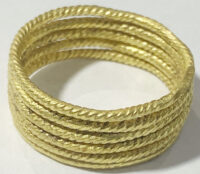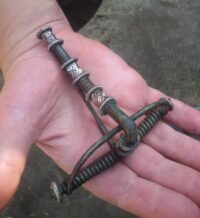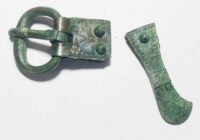Here’s to a 2022 replete with long-delayed archaeological digs, museum exhibitions attended by record-breaking crowds and lots of history nerd-themed travel. And if circumstances continue to make such resolutions too hard to keep, then we’ll just have keep the nerdfires burning virtually right here. 😎
Month: December 2021
Decapitated horse found in Merovingian grave
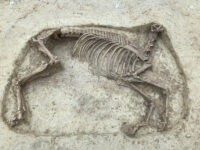 Archaeologists have unearthed a Merovingian-era cemetery in Knittlingen, southwestern Germany, that includes a beheaded horse laid to rest alongside his warrior rider. The excavation revealed more than 110 graves containing the remains of the local elite.
Archaeologists have unearthed a Merovingian-era cemetery in Knittlingen, southwestern Germany, that includes a beheaded horse laid to rest alongside his warrior rider. The excavation revealed more than 110 graves containing the remains of the local elite.
Today’s Knittlingen was founded in the Merovingian period (the first written record of it is Carolingian, dating to 843), but there is archaeological evidence of settlement going back to the Neolithic era. Graves from the Merovingian burial ground were first discovered in 1920 during construction of a narrow-gauge railway that was never completed. When real estate development was planned at the site in the 1980s, an archaeological survey encountered a few more graves, but the development did not move forward and the site was not thoroughly excavated until this summer.
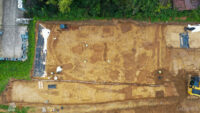 The Baden-Württemberg State Office for Monument Preservation (LAD) employed contractors ArchaeoBW to explore the area. As expected, the team encountered prehistoric findings, post holes, pits and trenches from Neolithic structures and fragments of ceramics dating to around 5000 B.C.
The Baden-Württemberg State Office for Monument Preservation (LAD) employed contractors ArchaeoBW to explore the area. As expected, the team encountered prehistoric findings, post holes, pits and trenches from Neolithic structures and fragments of ceramics dating to around 5000 B.C.
The main focus of the excavation, however, was the Merovingian cemetery. The goal was to uncover all of the inhumation burials at the site, and even though excavations will continue through the spring of 2022, archaeologists believe the cemetery has been fully revealed.
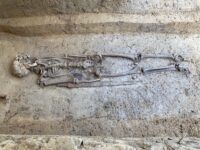 The graves were laid out in regular rows in largely chronological order, but the graves of some of the more notable members of the societal elite were out of sequence, buried within a circular ditch. Some of the graves were simple cut holes, but some individuals were buried in wooden coffins, and there were also more elaborate wooden chambers built to contain the remains of people of highest status.
The graves were laid out in regular rows in largely chronological order, but the graves of some of the more notable members of the societal elite were out of sequence, buried within a circular ditch. Some of the graves were simple cut holes, but some individuals were buried in wooden coffins, and there were also more elaborate wooden chambers built to contain the remains of people of highest status.
While the cemetery was extensively looted in the Middle Ages, archaeologists were able to recover a wide range of funerary artifacts, including pearl necklaces, fibulae, earrings, arm rings, disc brooches, belt fittings and utilitarian objects like knives and combs. Weapons — swords, spears, shields, arrowheads — were found in male burials. Pottery containing the remnants of food were interred as funerary offerings.
“Despite their fragmentation due to the ancient robbery, the finds give indications of the social status of the dead,” said [LAD officer Dr. Folke] Damminger. The comparatively rich burials from the second half of the sixth century are remarkable in Knittlingen. One woman was buried with almost complete fibula outfits typical of the time. A gold disc brooch worn individually from a somewhat younger grave, on the other hand, heralds the fashion of the seventh century. Some of the men’s graves identified the deceased as cavalrymen. A decapitated horse was buried in the vicinity of one of these burials. Bronze bowls testify to table manners based on the courtly model.
The accessory ensembles of the late seventh century, on the other hand, looked somewhat more modest. It is not known whether this is due to a decline in prosperity or to a change in the staging of the funerals of the local elites.
Mummy of Pharaoh Amenhotep I digitally unwrapped
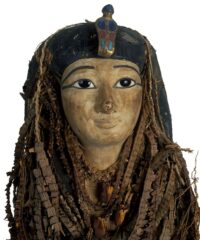 The mummy of Pharaoh Amenhotep I is a unique survivor of the destructive fashion for unwrapping mummies in the late 19th and early 20th century. It has managed to survive the 140 years since its discovery untampered with, thanks largely to the pristine beauty of its wrapping, complete with floral garlands and lifelike wood and cartonnage face mask. It is still pristine, but now thanks to CT scanning, the mummy of Amenhotep I has been unwrapped virtually.
The mummy of Pharaoh Amenhotep I is a unique survivor of the destructive fashion for unwrapping mummies in the late 19th and early 20th century. It has managed to survive the 140 years since its discovery untampered with, thanks largely to the pristine beauty of its wrapping, complete with floral garlands and lifelike wood and cartonnage face mask. It is still pristine, but now thanks to CT scanning, the mummy of Amenhotep I has been unwrapped virtually.
Amenhotep I was the second pharaoh of the 18th Dynasty, who ruled Egypt for two decades, from ca. 1524 to 1504 B.C. His original tomb has never been found, but his mummy was discovered in 1881 at the Deir el-Bahari Royal Cache in Luxor, hidden by priests of the 21st Dynasty to protect royal mummies from being damaged or destroyed by tomb raiders. The mummy was found in a wood coffin inscribed with the pharaoh’s name and recording that Amenhotep I had been rewrapped twice by 21st Dynasty priests of Amun. The pristine wrapping, therefore, was not original to his burial, but a later restoration dating to his reburial in the Royal Cache.
(Three thousand years later, Gaston Maspero, noted French Egyptologist and director-general of the antiquities of Egypt from 1881 until 1914, took over where the priests of Amun had left off. In his dogged pursuit of antiquities traffickers, he arrested the men who had secretly found the Deir el-Bahari cache of royal mummies and they confessed to their find under torture. Maspero quickly had the mummies moved to Cairo to protect them from tomb raiders. He was also responsible for the decision to keep Amenhotep I’s exceptional wrapping intact.)
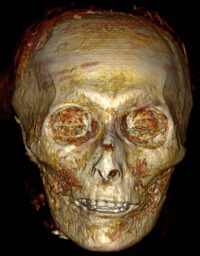 The mummy was X-rayed in the 1930s and again in the 1960s, but the technology wasn’t refined enough to provide much in the way of information about the pharaoh’s body. CT scans allowed the creation of a 3D model that can be visualized in its different compositional layers.
The mummy was X-rayed in the 1930s and again in the 1960s, but the technology wasn’t refined enough to provide much in the way of information about the pharaoh’s body. CT scans allowed the creation of a 3D model that can be visualized in its different compositional layers.
“This fact that Amenhotep I’s mummy had never been unwrapped in modern times gave us a unique opportunity: not just to study how he had originally been mummified and buried, but also how he had been treated and reburied twice, centuries after his death, by High Priests of Amun,” said Dr. Sahar Saleem, professor of radiology at the Faculty of Medicine at Cairo University and the radiologist of the Egyptian Mummy Project, the study’s first author. […]
We show that Amenhotep I was approximately 35 years old when he died. He was approximately 169cm tall, circumcized, and had good teeth. Within his wrappings, he wore 30 amulets and a unique golden girdle with gold beads.”
“Amenhotep I seems to have physically resembled his father: he had a narrow chin, a small narrow nose, curly hair, and mildly protruding upper teeth.”
Saleem continued: “We couldn’t find any wounds or disfigurement due to disease to justify the cause of death, except numerous mutiliations post mortem, presumably by grave robbers after his first burial. His entrails had been removed by the first mummifiers, but not his brain or heart.”
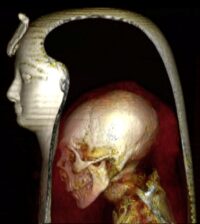 The scans also revealed that contrary to previous scholarship (including Saleem’s), the 21st Dynasty priests had carefully repaired mummies damaged by looters at the end of the 20th Dynasty, not used them as mines of prestige funerary materials. All of Amenhotep’s jewelry and amulets were preserved in the linen wrapping.
The scans also revealed that contrary to previous scholarship (including Saleem’s), the 21st Dynasty priests had carefully repaired mummies damaged by looters at the end of the 20th Dynasty, not used them as mines of prestige funerary materials. All of Amenhotep’s jewelry and amulets were preserved in the linen wrapping.
The research has been published in the journal Frontiers in Medicine and can be read in its entirety here.
Jersey acquires world’s largest Iron Age hoard
 The world’s largest Iron Age coin hoard, discovered on Jersey nine years ago, has been acquired by the Government of Jersey for £4.25 million ($5.7 million). The Council of Ministers dipped into the civil asset recovery fund (moneys confiscated from criminal activities) to pay Her Majesty’s Receiver General, administrator of the Crown estate in Jersey, for the right to keep their own patrimony.
The world’s largest Iron Age coin hoard, discovered on Jersey nine years ago, has been acquired by the Government of Jersey for £4.25 million ($5.7 million). The Council of Ministers dipped into the civil asset recovery fund (moneys confiscated from criminal activities) to pay Her Majesty’s Receiver General, administrator of the Crown estate in Jersey, for the right to keep their own patrimony.
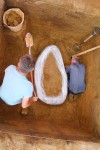 The Le Catillon II hoard was discovered by a pair of metal detectorists in February 2012. They had been searching that field for 30 years, looking for a coin treasure based on a tale they’d heard from the previous landowner’s daughter that she and her father had found coins in a jar buried in the field when she was a little girl. After three decades of fruitless searching, Reg Mead and Richard Miles found 60 coins of the Coriosolite tribe in what is now Brittany in one location. They dug down and encountered the top of what would prove to be a massive group of Celtic coins.
The Le Catillon II hoard was discovered by a pair of metal detectorists in February 2012. They had been searching that field for 30 years, looking for a coin treasure based on a tale they’d heard from the previous landowner’s daughter that she and her father had found coins in a jar buried in the field when she was a little girl. After three decades of fruitless searching, Reg Mead and Richard Miles found 60 coins of the Coriosolite tribe in what is now Brittany in one location. They dug down and encountered the top of what would prove to be a massive group of Celtic coins.
The find site was then thoroughly excavated by archaeologists who wrapped the mass of coins, hardened by corrosion into a half-ton block, and raised it in one giant chunk for excavation at the Jersey Museum in view of 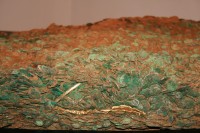 the public. Initial estimates of how many coins were crammed in there ranged from 30,000 to 50,000. As excavation continued, the estimate increased to 70,000; this turned out to be the accurate figure. Conservators then encountered a surprise: a section about the size of a shoebox containing six gold torcs. They also found other pieces of jewelry, glass beads, a leather purse and a woven bag containing silver and gold jewelry. It took five years to fully excavate the block. The last coin was removed in 2017.
the public. Initial estimates of how many coins were crammed in there ranged from 30,000 to 50,000. As excavation continued, the estimate increased to 70,000; this turned out to be the accurate figure. Conservators then encountered a surprise: a section about the size of a shoebox containing six gold torcs. They also found other pieces of jewelry, glass beads, a leather purse and a woven bag containing silver and gold jewelry. It took five years to fully excavate the block. The last coin was removed in 2017.
Treasure finds on Jersey are legally complicated because of its status as a self-governing Crown Dependency. The finders wanted the Le Catillon II hoard declared treasure under the UK’s legislation or, if the French law was applied, that it belonged to the finders and landowner. They tried to make a case of it, to loosen up the Crown Dependency chains a little bit, but nothing came of it, and a decade later it came down to a buyout. The hoard’s value was initially estimated at £10 million, so at least they got charged the friends price.
The historic collection of coins will now remain in Jersey Heritage’s care.
Part of the financial settlement included a £250,000 payment to Jersey Heritage for their work towards dismantling the coins, and an additional £250,000 which will be used to establish a trust. […]
The Crown will now undertake the work to establish an independent trust to promote scientific and educational research into the historic discovery.
Chief Minister John Le Fondre said the purchase was made “in the interest of the island”.
He said: “This is an outcome which will ensure that this unique part of Jersey’s history remains in the island for this and future generations.”
Riches, horses found in graves of “amber elites”
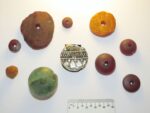 Archaeologists have unearthed richly furnished graves in a 3rd-7th century A.D. burial ground on the Sambian peninsula in Russia’s Kaliningrad oblast. They belonged to the elite of the late Roman, Migration Period and early Middle Ages, many of whom prospered thanks to the enduring trade in Baltic amber as well as other prized commodities like fur, homey and wax. The graves prove that a distinctive elite arose in the area in the 3rd century, two centuries earlier than previously believed.
Archaeologists have unearthed richly furnished graves in a 3rd-7th century A.D. burial ground on the Sambian peninsula in Russia’s Kaliningrad oblast. They belonged to the elite of the late Roman, Migration Period and early Middle Ages, many of whom prospered thanks to the enduring trade in Baltic amber as well as other prized commodities like fur, homey and wax. The graves prove that a distinctive elite arose in the area in the 3rd century, two centuries earlier than previously believed.
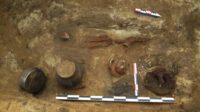 A team from the Institute of Archeology of the Russian Academy of Sciences began excavating the Putilovo-2 cemetery site three miles from the shores of the Baltic in 2015 for the first time in 150 years. In four years of exploration, they have revealed a two-acre burial ground. Excavations expanded this year in anticipation of new highway construction in the area.
A team from the Institute of Archeology of the Russian Academy of Sciences began excavating the Putilovo-2 cemetery site three miles from the shores of the Baltic in 2015 for the first time in 150 years. In four years of exploration, they have revealed a two-acre burial ground. Excavations expanded this year in anticipation of new highway construction in the area.
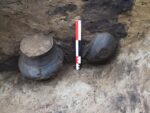 Most of them are cremation burials with cinerary remains interred in urns. They range from simple vessels buried in a small pit to large, elaborate urns buried in wooden boxes with extensive grave goods. The urns and coffins were covered with large slabs and then topped with stones. While the burials were extensively looted in the Middle Ages, both for their metal contents and for the slab stone reused by the Teutonic knights in castle construction. Ironically, slabs that collapsed into the graves ended up protecting the contents from looters as the broken slabs were no longer usable and thieves assumed there was nothing left under the busted roof.
Most of them are cremation burials with cinerary remains interred in urns. They range from simple vessels buried in a small pit to large, elaborate urns buried in wooden boxes with extensive grave goods. The urns and coffins were covered with large slabs and then topped with stones. While the burials were extensively looted in the Middle Ages, both for their metal contents and for the slab stone reused by the Teutonic knights in castle construction. Ironically, slabs that collapsed into the graves ended up protecting the contents from looters as the broken slabs were no longer usable and thieves assumed there was nothing left under the busted roof.
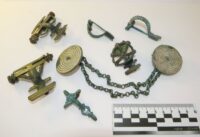 Grave goods that have been discovered thus far include pottery, jewelry of bronze, silver and gold, fibulae in a wide variety of shapes and sizes, torques, bangles, belt buckles, amber beads, weapons and tools. Roman silver and brass coins minted in the 1st and 2nd centuries were found in large numbers in the 4th-5th century graves. By this time they weren’t simple currency so much as objects of great symbolic value.
Grave goods that have been discovered thus far include pottery, jewelry of bronze, silver and gold, fibulae in a wide variety of shapes and sizes, torques, bangles, belt buckles, amber beads, weapons and tools. Roman silver and brass coins minted in the 1st and 2nd centuries were found in large numbers in the 4th-5th century graves. By this time they weren’t simple currency so much as objects of great symbolic value. 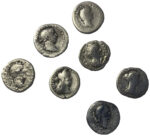 Archaeologists believe they may have been deemed to have currency value in the afterlife, which is why they were found in the graves of people of all ages and classes.
Archaeologists believe they may have been deemed to have currency value in the afterlife, which is why they were found in the graves of people of all ages and classes.
Four of the graves were marked as members of the local elite by their contents. One features a large urn buried with a jar, a spearhead, a bronze dagger, a fibula, scissors, a gold ring, an iron shield 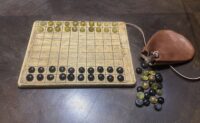 boss and a unique large set of glass game pieces for the board game Ludus latrunculorum. The game was popular throughout the Roman Empire and environs including modern-day Poland and Scandinavia. This set is extraordinary because there are almost 100 pieces that were preserved in a pouch. Nothing like it has been found in the Kaliningrad region for 170 years, and never before in the Sambian peninsula.
boss and a unique large set of glass game pieces for the board game Ludus latrunculorum. The game was popular throughout the Roman Empire and environs including modern-day Poland and Scandinavia. This set is extraordinary because there are almost 100 pieces that were preserved in a pouch. Nothing like it has been found in the Kaliningrad region for 170 years, and never before in the Sambian peninsula.
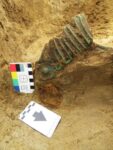 This man in this grave was so important that he was buried with not one, not two, but three horses. One of them still had its bronze bridle on its mandible and another was buried with his grooming kit bag. There were other horse burials in the cemetery, but this is the only triple header.
This man in this grave was so important that he was buried with not one, not two, but three horses. One of them still had its bronze bridle on its mandible and another was buried with his grooming kit bag. There were other horse burials in the cemetery, but this is the only triple header.
The excavation is scheduled to continue for another six months. The artifacts will be cleaned and conserved for eventual display in area museums.
